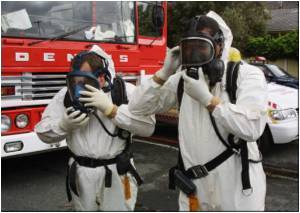A section of the anthrax toxic Lethal Factor could help produce a more effective vaccine, a team of researchers have identified.

Infection can occur from contact with infected livestock, meat or hides, but most people know about anthrax from its use as a biological weapon, notably in the 2001 attacks through the US postal system. The anthrax bacterium can be used in this way because its spores survive for long amounts of time and are easily reproduced.
The international research team led by Professor Danny Altmann from Imperial College London was funded by US National Institute of Health (NIH) to explore a new form of vaccine against the anthrax bacterium. Published in PLOS Pathogens the study focussed on the part of the toxin known as the 'Lethal Factor' (LF). The interest in LF was triggered by research on a cohort of Turkish farmers who had developed natural immunity to the less dangerous form of cutaneous anthrax.
By studying this group and using a mouse model, the researchers mapped the regions of the LF toxin targeted by protective T lymphocytes (a type of white cell that is essential for human immunity). They found a specific part that could form the basis for a vaccine since it elicits a highly effective immune response and works across a wide range of people. Using this section of the LF protein they successfully protected mice against the toxic effects of the anthrax bacterium.
Professor Altmann from Imperial College London's Department of Medicine said: "We have discovered a tiny section of protein that could potentially protect against this horrific disease. Although we mostly work at the molecular level of immunity we wanted to start with the bigger picture so we studied a community of Turkish farmers exposed to anthrax to see how their natural immunity had developed."
Vaccination works by stimulating our immune systems to make protective antibodies. The toxic effects of anthrax are caused by a combination of three proteins – Protective Antigen (PA), Edema factor (EF) and Lethal Factor (LF). On their own each of these individual proteins are not toxic but they can still produce an immune response in terms of stimulating white blood cells. This makes them potential candidates on which to base a vaccine.
Advertisement
Until now these have focussed on the Protective Antigen (PA) protein as a means to stimulate the immune system but these vaccines require extensive treatment regimes and there are concerns about effectiveness and longevity. Research on immunity in the Turkish farmers who had developed cutaneous anthrax indicated they had developed a natural immune response to both PA and LF, suggesting that immunity to the Lethal Factor (LF) protein may contribute to protection.
Advertisement
Finally, in collaboration with a team at the Defence Science and Technology Laboratory Porton Down, the researchers treated mice with a vaccine based on this region of the LF protein. This was shown to provide protection to the mice against the toxic effects of anthrax bacterium.
"Perhaps 90 per cent of research into anthrax vaccines has looked at PA but there are many other proteins to consider, including LF," said Professor Altmann. "In this research we are not trying to revolutionise current vaccines, which is a long-haul process. Rather we are trying to demystify the immunology of this frightening infection, hopefully providing clues to help develop future vaccines."
Source-Eurekalert










